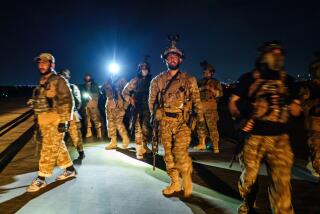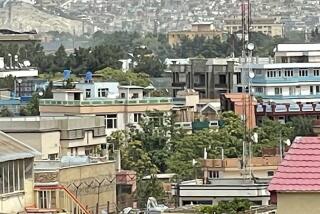U.S. Airstrikes Hit Suspected Taliban Convoy
- Share via
WASHINGTON — U.S. helicopter gunships and fighter jets attacked a large convoy of Taliban leaders and the command compound it was leaving in eastern Afghanistan, Defense Secretary Donald H. Rumsfeld said Friday.
The Pentagon strongly denied a report from the region that the convoy was actually made up of tribal elders.
Rumsfeld said the strike on the convoy and compound, southwest of the Tora Bora mountain complex of caves and tunnels, killed “a lot of people.” The strikes also destroyed most of the vehicles in the convoy, he said.
The convoy of 10 to 12 trucks was hit about 23 miles west of Khowst, a town in eastern Paktia province, defense officials said. They said the strikes, about 9 p.m. Thursday, also hit a command-and-control facility.
The generally pro-Taliban Afghan Islamic Press news agency in Pakistan reported that 65 people were killed in the attack and that they included Afghan tribal elders and former moujahedeen commanders on their way to Kabul, the capital, to attend today’s inauguration of Afghanistan’s interim government.
The agency quoted local Afghans as saying informants had wrongly told U.S. intelligence sources that the convoys were carrying Taliban leaders.
The Pentagon said it launched the strikes after receiving intelligence reports. “The convoy containing the Taliban leaders was the only convoy we struck,” a U.S. defense official said.
Marine Lt. Col. Dave Lapan, a Pentagon spokesman, told Reuters news agency: “There is no doubt in their [U.S. Central Command’s] mind that they hit what they wanted to hit and that it was the bad guys. . . . It was Taliban leadership. Central Command went back and looked at everything that they did, and they hit exactly what they wanted to hit.”
The attack on the convoy was the first U.S. airstrike in three days. The bombing campaign has been on hold while Afghan and U.S. troops intensify their search of the caves and tunnels of Tora Bora for clues on where terrorist leaders, including Osama bin Laden, may be hiding.
Rumsfeld called the search “dangerous work” and said that there have been “dust-ups” between U.S. commandos and Al Qaeda fighters outside the caves. But he said the effort was fueled by “a sense of urgency.”
He added that searches of caves, houses and camps elsewhere in Afghanistan have yielded important clues that have “directly resulted in the arrest of people across the world--other side of the globe--and undoubtedly prevented other terrorist activities.”
He didn’t elaborate on the arrests but said more troops from the U.S. and other countries will soon join what he called an extraordinarily difficult search through the rubble of the bombed mountain complexes.
“Whatever is needed will be sent,” Rumsfeld said. “And it won’t be just U.S.--it will be coalition forces.”
Pentagon officials said that, to aid in the search, they have shipped 10 laser-guided bombs to Afghanistan to blast open caves. The thermobaric weapon uses a delayed, high-pressure explosion to suck the air out of caves and tunnels.
It “is something we clearly have a need for in Afghanistan, and they’re on their way over there,” Undersecretary of Defense Edward C. Aldridge told reporters.
Pentagon officials had hoped to delegate the dangerous cave searches to Afghan allies.
But heavy bomb damage to the mountain redoubts has made the task difficult. And the U.S. hopes that by sending its own specialists into the caves, it can better sift through evidence that could lead authorities to Bin Laden and other Al Qaeda leaders.
Rumsfeld declined to say whether Marines or Army troops would be sent to scour the caves.
Meanwhile, President Bush has directed the National Security Council to devise a broad legal procedure to deal with the hundreds of Al Qaeda fighters already in captivity.
Confusion Among Various Interrogators
As the number of prisoners and “detainees” grows at a makeshift prison at the airport in the former Taliban stronghold of Kandahar, there has been confusion among FBI, CIA and military interrogators over who gets to question whom and in what order.
Those in custody range from youthful Afghan fighters to hard-core Al Qaeda terrorists from other countries, officials say. Interrogators want to distinguish between the two.
The president said Friday that he had ordered council members to “take their time” but to come up with a broad mechanism that could “address all the different circumstances that may arise.”
“When we capture somebody who has a certain characteristic to him, then the process ought to automatically kick in as to how that person is dealt with,” Bush said. “And I think we owe that to the country to take our time.”
A National Security Council official later explained that such a process is needed because of the unusual nature of the anti-terrorist conflict in Afghanistan.
“You have here a unique set of circumstances: The United States is in a coalition to root out a terrorist organization that is being protected by a regime that is not recognized by any government,” he said, adding that the many nationalities and allegiances among the fighters further complicate the matter.
No Decision Yet on American Talib
The president wants to put in place “a rational, coherent and consistent way that allows you to systematically go through and decide what to do with the various types of people,” the official added.
Bush said he is taking his own advice to be deliberate as he weighs the case of John Walker Lindh, the so-called American Talib who may face charges ranging from treason to providing material support or resources to terrorists.
Asked if he has ruled out treason as a possible charge against Lindh, the president replied: “No. Nothing has been ruled out because I want to make--obviously every decision we make at this point will set precedent for future decisions, and I . . . want us to fully think through all the ramifications of the different options.”
Also Friday, the president urged his Pakistani counterpart, Gen. Pervez Musharraf, to crack down on two groups that the U.S. has accused of backing terrorism, and Bush offered to help in that effort.
“The president calls on him to take action against the Lashkar-e-Taiba, Jaish-e-Mohammed and other terrorist organizations, their leaders and their finances,” White House Press Secretary Ari Fleischer said.
*
Times staff writer Carol J. Williams in Kabul contributed to this report.
More to Read
Sign up for Essential California
The most important California stories and recommendations in your inbox every morning.
You may occasionally receive promotional content from the Los Angeles Times.










